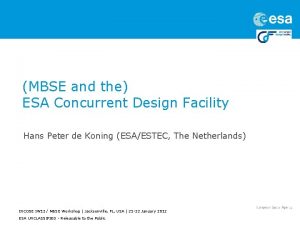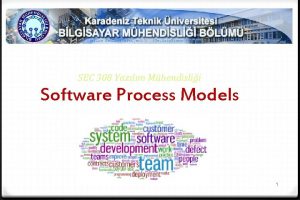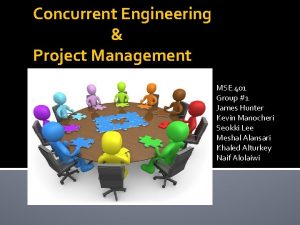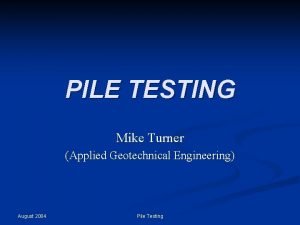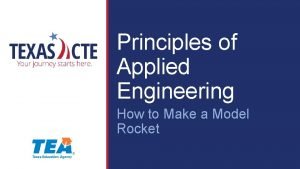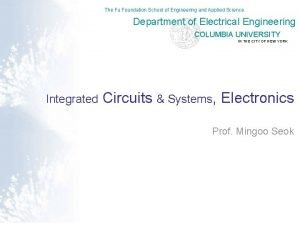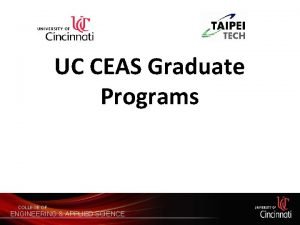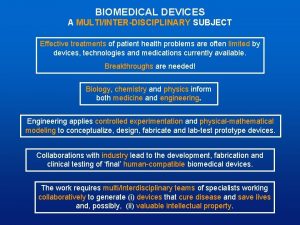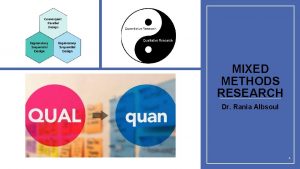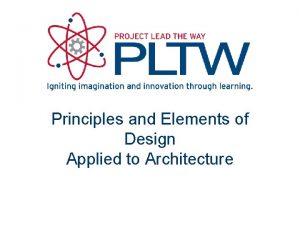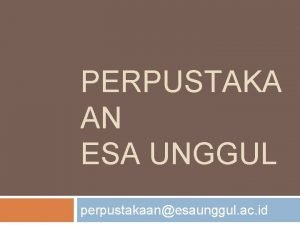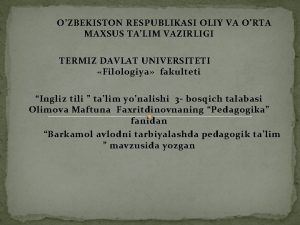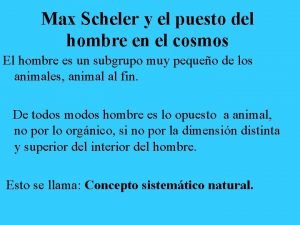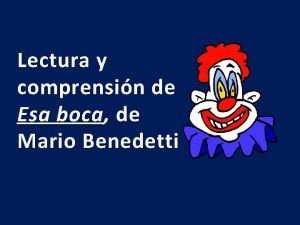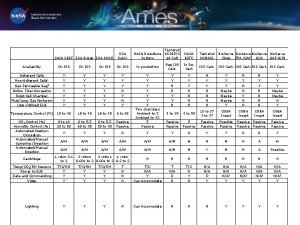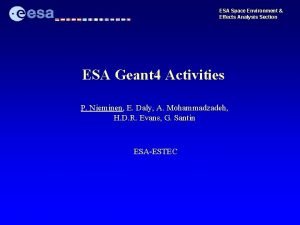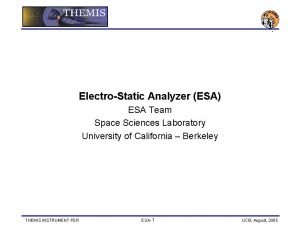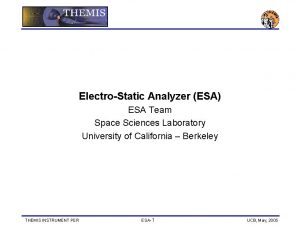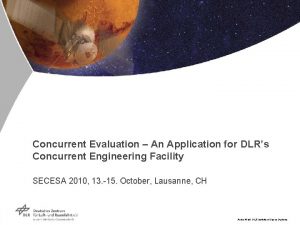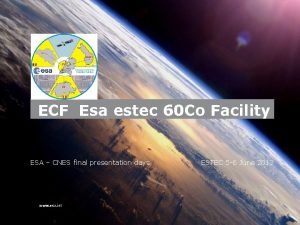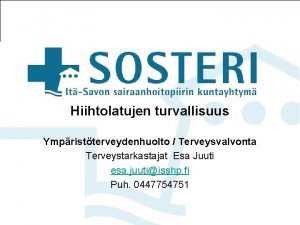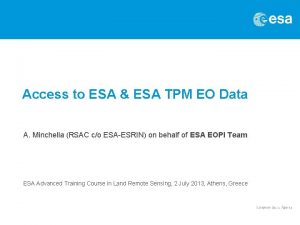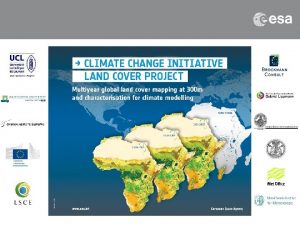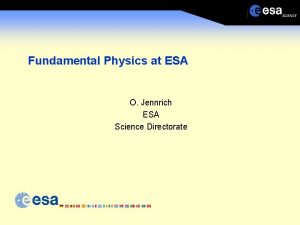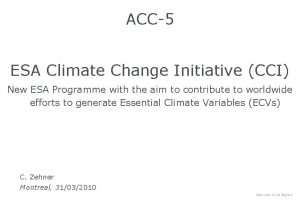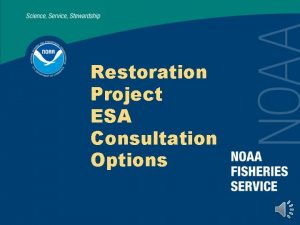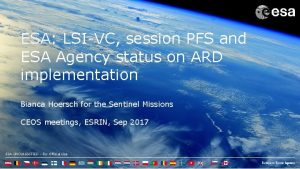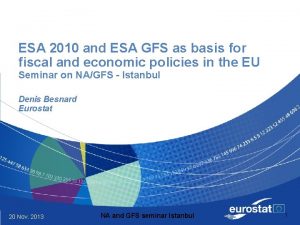ESA Concurrent Design Concurrent Engineering applied to space



















- Slides: 19

ESA Concurrent Design: Concurrent Engineering applied to space mission assessments K. Nergaard ESA – OPS-HSA

ESA FACTS AND FIGURES • Over 30 years of experience • 18 Member States • Five establishments, about 2000 staff • 3 600 million Euro budget (2009) • Over 60 satellites designed and tested • • More than 10 scientific satellites in operation Five types of launcher developed • Over 180 launches made KSEE Presentation 2010 2

ESA Member States • Austria, Belgium, Czech Republic, Denmark, Finland, France, Germany, Greece, Ireland, Italy, Luxembourg, Norway, the Netherlands, Portugal, Spain, Sweden, Switzerland the United Kingdom. • Canada takes part in some projects under a Cooperation Agreement. • Hungary, Romania and Poland are European Cooperating States. • • Cyprus, Slovenia, Estonia and Latvia have recently signed Cooperation Agreements with ESA. KSEE Presentation 2010

ESA – What do we do? KSEE Presentation 2010 4

The ESA project life-cycle = CDF application / quantity I n d u s t r y E S A Evolving Applications Phase A Phase C/D Phase B … Launch Pre. Ph. A 100+ SPEC. ’s 20 Review 12 SPEC. ’s 2 3 Review SPEC. ’s 1 2 Lessons Learned KSEE Presentation 2010 CDR … FDIR

Why do we need Concurrent Engineering? • To overcome the communication gaps between the “designer” (who produces design information) and the “user” (who utilises the design information) Sequential Design (“over-the-fence” approach) KSEE Presentation 2010 6

Possible approaches to system design Centralised design Concurrent design KSEE Presentation 2010 7

The Concurrent Design Facility (CDF): what is it? • The ESA Concurrent Design Facility is an Integrated Design Environment (IDE) available to all ESA programmes for interdisciplinary and inter-directorate applications, based on Concurrent Engineering methodology • the implementation started in Nov. 1998, on an experimental basis with initiative (and support) of the General Studies Programme (GSP) • initially conceived for the assessment and the conceptual design of future space missions, i. e. internal pre-phase A / feasibility studies • the main ESA CDF is in ESTEC with other establishments having satellite CDF systems (such as ESOC) • featuring: – team orientated concurrent engineering – integration of tools, project data, mission and system models – simultaneous participation of all mission domains, incl. Programmatics/AIV, Operations, Cost Engineering, Risk Analysis, CAD, Simulation KSEE Presentation 2010 8

CDF: the approach (Organisation dependent) • Re-organization of existing tools and human resources in a more effective (i. e. “concurrent”) way Technical Domains Domain Engineering Tools & DB‘s Specialists Interfacing Group Data Sharing System Perspective Integrated Design Environment KSEE Presentation 2010 Team Engineers

CDF: the achievements Activities performed • 100+ (potential) future missions studied and designed internally at pre-Phase A, conceptual, system level • 4 new launcher concept design • 11 complex payload instrument design (IDA), incl. Platform, system, mission • 18 reviews of Industrial Phase A studies (internal + Industry) and Phase B • 5 ISS on-board facilities/experiments accommodation studies; teaming with/supporting Industry in Phase A • Joint studies with NASA/JPL/PDC-Team X (Distributed Concurrent Engineering), CNES CIC, DLR, Industry, Academia • Anomaly investigation for later project phases • Educational, training, promotion and standardisation activities Spin-off • Transfer of CDF know-how and software to national Agencies, Industry, Academia KSEE Presentation 2010 10

Benefits • • Performances (typical pre-Phase A study): – Study duration (Design phase): 3 -6 weeks (“classical” 6 -9 months!) – Factor 4 reduction in time – Factor 2 reduction in cost (for the Customer) – Increased number of studies per year, compatibly with max 2 parallel studies Improvement in quality, providing quick, consistent and complete mission design, incl. technical feasibility, programmatics, risk, cost • Technical report becomes part of the specs for subsequent industrial activity, Cost report remains the ESA independent reference • Capitalisation of corporate knowledge for further reusability • CDF: an essential tool for the ESA Decision Making and Risk Management processes KSEE Presentation 2010

Process elements • Conducted in sessions – plenary meeting where representatives of all space engineering domains participate from early phases (requirement analysis) to end of design (costing) – 6 to 10 session / study, 4 hour / session, bi-weekly frequency – team leader co-ordination – customer participation • Model driven • On-line design • Highly co-operative & interactive • Iterations • Design options comparison and trade-offs KSEE Presentation 2010 12

Design process Mission requirements & constraints Objectives Software Attitude determination & control Study results Instruments Data handling Environment S/C Design Lifetime Electrical power Payload Reliability Schedule Technology Mission analysis Planning Resources KSEE Presentation 2010 Launcher Cost Dry mass Operations & ground systems Propulsion Products Study Level S/C Configuration Risk Thermal control Budget Study requirements Telemetry tracking & command Simulation Programmatics Options Structure Wet mass Propellant mass Adapter Launch mass Conceptual model of mission & spacecraft design process 13

The Spiral Model CE: iterative process Mission analysis Mission requirements analysis Sub-system design Design verification Cost analysis Risk assessment KSEE Presentation 2010 Key Parameters

CDF: the team • Team of ESA specialists (senior and junior!) • Technical disciplines (‘CDF positions’) selected for Phase 0 studies (according to ESA organisation): Systems Instruments Mission analysis Propulsion Attitude and Orbit Control Structures/Configuration Mechanisms/Pyros Thermal Power Command Data Handling Communications Ground Systems & Operations Simulation Programmatics Risk Assessment Cost Analysis Black: sub-system level Blue: system level Red: based on hi-end tools Note: Instrument design activities have specialised teams with disciplines such as Receiver, Optics etc. KSEE Presentation 2010

Payload & P/L accommodation Advanced launchers Socrates ROSITA instrument on Columbus External Platform Heavy Lift Launch Vehicle Diverse range of space missions Crewed vehicles for exploration preparation programme S 5 P Exo. Mars Human Missions to Mars Telescopes and Technology FIRI Moon Lander ISS Internal Payload – Science Requirements Definition IMPACT facility inside an ISS rack KSEE Presentation 2010 Wi. FLY Laplace 16

New CDF application - System of Systems architecture Service oriented – Example: GIANUS • • • Architecture and integration of independent space assets and systems to provide a layer of global services (e. g. security) Collaboration among ESA programme directorates and other Agencies Support EU and national authorities dealing with Civil Crisis Management (ref. EC-EDA-ESA workshop - 16 Sep. 2009 - on Space for Security and Defence) KSEE Presentation 2010

A CDF design session KSEE Presentation 2010 18

Thanks for your time! KSEE Presentation 2010
 Esa concurrent design facility
Esa concurrent design facility Esa multimedia.esa.int./multimedia/virtual-tour-iss
Esa multimedia.esa.int./multimedia/virtual-tour-iss Software engineering
Software engineering Concurrent engineering in project management
Concurrent engineering in project management Applied geotechnical engineering
Applied geotechnical engineering Principles of applied engineering
Principles of applied engineering The fu foundation school
The fu foundation school Uc ceas
Uc ceas Gerling applied engineering
Gerling applied engineering Albsoul
Albsoul Scale and proportion in architecture
Scale and proportion in architecture Unscented trajectory chapter 5
Unscented trajectory chapter 5 Space junk the space age began
Space junk the space age began Camera space to world space
Camera space to world space Unscented trajectory chapter 5
Unscented trajectory chapter 5 World space computer
World space computer Perpus esa unggul
Perpus esa unggul Talimni tarbiyadan tarbiyani esa
Talimni tarbiyadan tarbiyani esa Concepción del hombre
Concepción del hombre Esa boca de mario benedetti pdf
Esa boca de mario benedetti pdf
